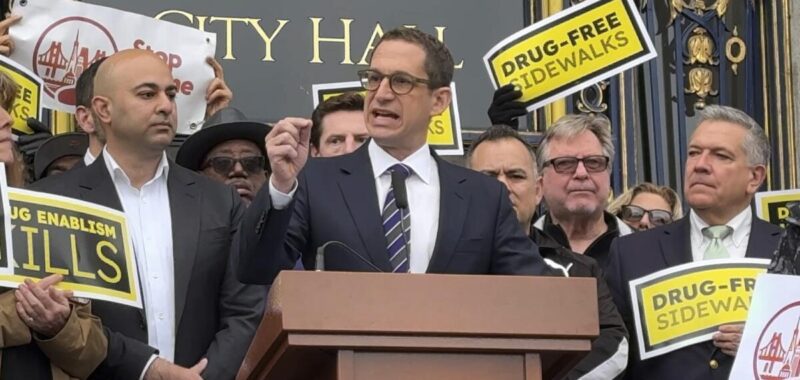SAN FRANCISCO — San Francisco Mayor Daniel Lurie, who won election in November on the pledge to crack down on the city’s fentanyl crisis, announced a new public health policy Wednesday that will more forcefully push treatment on drug users seeking clean needles and other supplies tied to their addiction.
The new policy, to take effect April 30, marks a dramatic shift from the strategies San Francisco has used in recent years to encourage — but not pressure — illicit drug users into treatment, even as overdoses topped 800 in 2023. Though overdose numbers fell last year, preliminary data for 2025 show them creeping back up.
For years, San Francisco and other cities have fostered the growth of community programs that provide so-called harm reduction services. Such programs generally target homeless people struggling with addiction, sending out street workers to distribute sterile syringes and clean smoking kits — foil, pipes and straws, for example — with the aim of preventing transmissible diseases such as HIV and Hepatitis C. Many such programs also distribute Narcan, a medication that can rapidly reverse the effects of opioid overdoses.
The harm-reduction approach has staunch defenders, who say the strategy helps safeguard people with drug addictions until they are ready to commit to treatment. The strategy also has weary critics who say the notion of “meeting addicts where they are” has not proven effective enough at getting people to seek treatment or lowering death rates.
During a news conference at City Hall, Lurie said the days of San Francisco handing out drug supplies without connecting people to treatment “are over,” and that the overdose crisis, fueled by fentanyl, mandates a more aggressive response.
“We have so much work to do in this city,” Lurie said. “We are seeing people struggling with addiction. We are seeing people die of overdose. And we have to make a change.”
Under the new policy, city staff and nonprofits that receive city funding are barred from handing out sterile syringes and other supplies unless they actively work to connect people with treatment and counseling. The policy prohibits workers from passing out smoking supplies in streets, parks and other public spaces, instead requiring such handouts be conducted indoors or at city-sanctioned locations. It does not change the rules around distributing clean syringes in public.
“We are really trying to get proactive here, instead of waiting, watching folks die,” said Daniel Tsai, director of the San Francisco Public Health Department.
The tougher restrictions follow in the wake of the Trump administration’s announcement last month that it was revoking billions in federal grants that help fund mental health and addiction services across the country. The prospect of major cuts in federal funding for community-level services is particularly worrisome for San Francisco leaders, who are facing a budget deficit of nearly $1 billion starting this year.
Lurie, who has generally avoided talking about Trump during his first months in office, said his administration would “focus on what we can control right now.” In recent weeks, he has announced a series of policy shifts to move San Francisco away from what its critics — and many voters — perceive as a soft approach to deterring the open drug dealing and drug use that plague some neighborhoods, including downtown and the Tenderloin and South of Market districts.
Soon after taking office in January, Lurie worked with the Board of Supervisors to pass a measure giving his office more authority to bypass bureaucratic hurdles that have slowed expansion of shelter and treatment programs for homeless people, as well as more leeway to pursue private funding to finance those initiatives.
He is working to open a 24/7 “stabilization center” in the heart of the Tenderloin where police can drop off people who need medical care. He is also pushing forward with a campaign promise to open 1,500 more treatment beds.
Lurie’s early efforts have alarmed some front-line street workers who say he is abandoning strategies that effectively prevent overdoses.
Tyler TerMeer, chief executive of the San Francisco AIDS Foundation, warned that the new policy could result in more people turning from smoking drugs to injecting them, raising the likelihood of people overdosing and contracting infectious diseases.
“San Francisco AIDS Foundation stands firm in our knowledge that providing people with the information and resources they need to take care of themselves, including safer-use supplies and treatment and counseling services, is best for the health of people who use substances,” TerMeer said.
Lurie’s office said the public health department will monitor overdose rates and the transmission of HIV and Hepatitis C “to ensure this policy aligns with overall public health goals.”
Both Lurie and Tsai acknowledged the new approach will not be easy to implement. For one, the city does not have anywhere near enough treatment beds to accommodate all the people in need. And the rules stop short of forcing people into treatment. Still, Lurie said, San Francisco has to upend the status quo even as it expands capacity for treatment and interim housing.
“What we are doing is not working,” Lurie said. “I am not going to sit by and not take action.”

